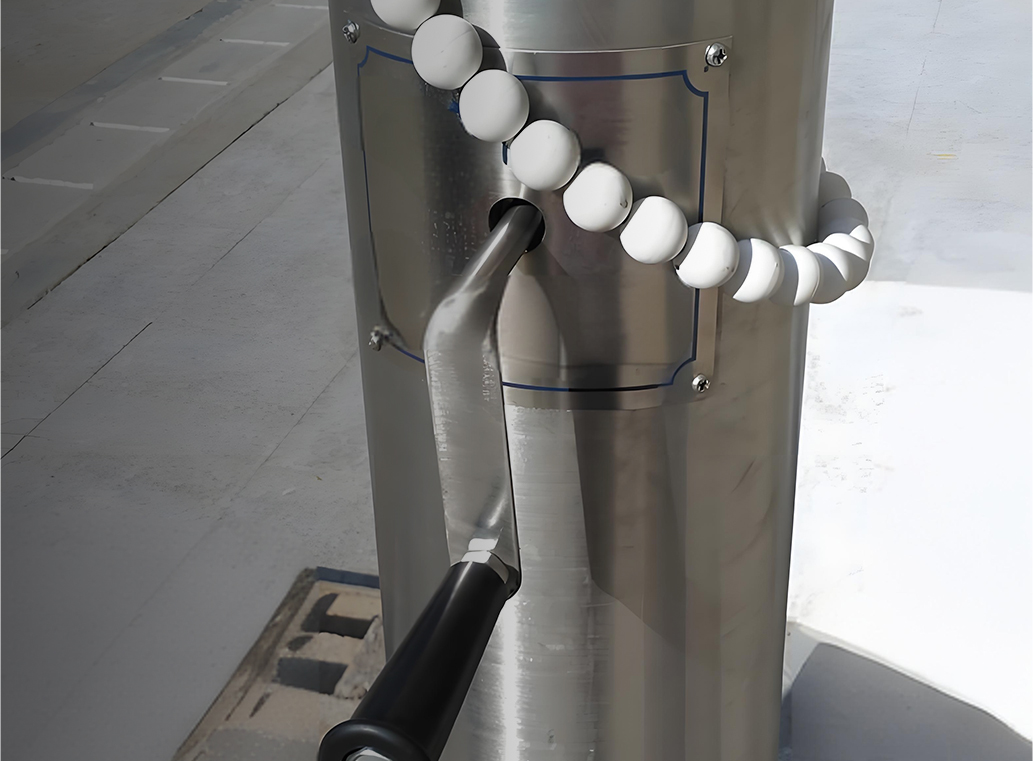Flagpoles stand as proud symbols, gracing homes, businesses, and public spaces alike. While various materials are used in their construction, stainles......
READ MORESubmit feedback
The Ultimate Guide to Stainless Steel Flagpoles: Choosing, Installing, and Maintaining
Flagpoles stand as proud symbols, gracing homes, businesses, and public spaces alike. While various materials are used in their construction, stainless steel flagpoles have emerged as a superior choice, renowned for their exceptional durability, striking aesthetics, and unwavering performance. Unlike their counterparts made from aluminum or fiberglass, stainless steel flagpoles offer a unique blend of strength and elegance that ensures a lasting display of your chosen flag.
Why Choose Stainless Steel for Your Flagpole?
When considering a flagpole, the material choice is paramount. While aluminum and fiberglass flagpoles have their merits, stainless steel stands head and shoulders above the rest, offering a compelling array of benefits that ensure a long-lasting, visually appealing, and robust flag display.
Durability and Longevity
One of the most significant advantages of stainless steel flagpoles is their unparalleled durability and lifespan. This is primarily due to their exceptional corrosion resistance and inherent strength.
Corrosion Resistance: Stainless steel's remarkable ability to resist rust and corrosion is a game-changer for outdoor structures. Unlike iron-based materials that readily succumb to oxidation, stainless steel contains chromium, which forms a passive layer on its surface. This layer acts as a barrier, protecting the metal from the corrosive effects of rain, humidity, salt air, and pollution. This means your stainless steel flagpole will maintain its pristine appearance and structural integrity even in harsh weather conditions, from coastal environments to areas with high industrial emissions.
Lifespan Compared to Aluminum or Fiberglass: While aluminum is lighter and fiberglass offers flexibility, neither can match the long-term resilience of stainless steel. Aluminum can pit and discolor over time, and while it resists rust, it can still degrade in certain environments. Fiberglass, though flexible, can become brittle with prolonged UV exposure and extreme temperature fluctuations, potentially leading to cracking or splintering. Stainless steel, by contrast, is engineered for decades of reliable service, often outlasting the property it adorns with minimal degradation.
Aesthetic Appeal
Beyond its impressive resilience, stainless steel brings a sophisticated and modern aesthetic to any setting.
Modern and Sleek Look: The inherent luster and clean lines of stainless steel project an image of contemporary elegance. Its reflective surface can subtly catch and reflect light, adding a dynamic visual element without being overly ornate. This sleek appearance makes it a versatile choice that complements a wide range of architectural styles, from traditional to ultra-modern.
Suitability for Various Environments: Whether gracing the entrance of a corporate headquarters, standing tall in a meticulously landscaped residential garden, or adorning a public monument, the timeless appeal of stainless steel seamlessly integrates into diverse environments. Its understated sophistication enhances the surroundings without detracting from the flag it supports.
Strength and Wind Resistance
A flagpole's primary function is to proudly display a flag, and in doing so, it must withstand the forces of nature, particularly wind. Stainless steel excels in this crucial aspect.
How Stainless Steel Handles High Winds: Stainless steel boasts an incredibly high tensile strength, meaning it can withstand significant pulling forces before deforming or breaking. This inherent strength makes it exceptionally resistant to bending and buckling even in gale-force winds. The solid, robust construction of stainless steel flagpoles ensures they remain upright and stable, minimizing the risk of damage to the flagpole itself or surrounding property during severe weather events.
Importance of Proper Installation for Wind Resistance: While the material itself is formidable, the flagpole's ability to resist high winds is also heavily reliant on its installation. A stainless steel flagpole's superior strength is maximized when it is properly anchored with a deep, robust foundation. This ensures that the forces exerted by strong winds on the flag are effectively transferred to the ground, preventing the pole from leaning, shifting, or even toppling. Investing in professional, secure installation is therefore just as crucial as choosing a high-quality stainless steel pole.

Types of Stainless Steel Flagpoles
Stainless steel flagpoles come in various designs, each catering to different applications and aesthetic preferences. Understanding these types is crucial for selecting the flagpole that best fits your specific requirements, whether for a cozy backyard or a grand commercial complex.
Residential Flagpoles
Designed primarily for home use, residential flagpoles offer a balance of aesthetic appeal, ease of installation, and durability.
Sizes and Heights for Home Use: Residential stainless steel flagpoles typically range from 15 to 25 feet in height, with 20-25 feet being common for a two-story home. These sizes are ideal for ensuring your flag is prominently visible without overwhelming the scale of a typical residential property. They are often one-piece or sectional designs that are easier for homeowners to manage and install.
Easy Installation Options: Many residential stainless steel flagpoles are designed for relatively straightforward DIY installation, though professional installation is always recommended for optimal stability and longevity. They often come with kits that include the necessary components for setting a ground sleeve foundation.
Commercial Flagpoles
Commercial flagpoles are built to a higher standard, engineered to withstand greater wind loads and more frequent use, making them suitable for businesses, institutions, and public spaces.
Heavy-Duty Options for Businesses: These flagpoles are significantly taller and more robust than residential models, often ranging from 25 feet to over 100 feet. They feature thicker wall gauges and larger butt diameters to handle the increased stress of larger flags and higher wind speeds common in commercial areas.
Compliance with Regulations: When installing a commercial flagpole, it's vital to be aware of local zoning laws, building codes, and any homeowner association (HOA) regulations that may dictate maximum height, setback requirements, and permitting. Commercial installations often require professional engineering and installation to ensure safety and compliance.
Telescoping Flagpoles
Telescoping flagpoles offer unique flexibility, allowing for adjustable height and easy portability.
Benefits of Adjustable Height: The primary advantage of a telescoping flagpole is its ability to extend and retract, much like a telescope. This feature allows users to easily adjust the height of their flag display or collapse the pole for storage during severe weather or when moving.
Ease of Use and Storage: These flagpoles often feature a "no-rope" design, relying on interlocking sections that slide and lock into place. This eliminates the need for halyards (ropes) and cleats, reducing tangling and noise. Their collapsible nature makes them relatively easy to transport and store when not in use.
In-Ground vs. Outrigger Flagpoles
The installation method also defines a type of flagpole, with in-ground and outrigger being two common categories.
Differences in Installation and Stability:
In-Ground Flagpoles: These are the most traditional and stable type, with the pole embedded directly into a concrete foundation in the ground. This method provides maximum structural integrity and is ideal for permanent, freestanding flag displays.
Outrigger Flagpoles: Also known as wall-mounted flagpoles, outrigger designs are attached to the side of a building or structure at an angle. They are a great solution where ground space is limited or when a flag needs to be prominently displayed on a building facade.
Best Uses for Each Type: In-ground flagpoles are suitable for almost any open area, offering a classic and imposing display. Outrigger flagpoles are perfect for storefronts, public buildings, or homes where a ground installation isn't feasible or a unique architectural statement is desired. Some outrigger flagpoles may also be vertically mounted.
|
Flagpole Type |
Primary Use |
Typical Heights (Stainless Steel) |
Key Features |
Installation |
|
Residential |
Homes, smaller properties |
15-25 feet |
Aesthetically pleasing, lighter duty |
Designed for DIY or light professional installation |
|
Commercial |
Businesses, public spaces |
25-100+ feet |
Heavy-duty construction, high wind resistance |
Requires professional installation, often permitted |
|
Telescoping |
Versatile residential/light commercial |
15-25 feet |
Adjustable height, no ropes/pulleys, portable |
Easier DIY installation, can be removed |
|
In-Ground |
Freestanding, permanent display |
All heights (residential & commercial) |
Maximum stability, traditional look |
Requires concrete foundation, permanent |
|
Outrigger (Wall-Mounted) |
Building facades, limited ground space |
Various (often 6-20 ft) |
Angled display from a building, space-saving |
Mounted directly to a building structure |
Choosing the Right Size and Height
Selecting the correct size and height for your stainless steel flagpole is paramount, not just for aesthetic appeal, but also for compliance with local regulations and ensuring the flag is displayed appropriately. A flagpole that is too tall can overwhelm a property, while one that is too short may not allow the flag to fly freely or be adequately visible.
Factors to Consider
Before you even look at flagpole specifications, take stock of your environment and local guidelines.
Property Size and Surroundings:
Scale: The flagpole's height should be proportional to the size of your property and the height of surrounding structures (your house, commercial building, tall trees). A general rule of thumb is that the flagpole should be tall enough to be seen clearly without appearing dwarfed by its surroundings, but not so tall that it dominates the landscape.
Visibility: Consider where you want the flag to be seen from. If it's for a residential home, you might want it visible from the street. For a business, visibility from a main road might be key.
Overhead Obstructions: Look up! Ensure there are no overhead power lines, tree branches, or other obstructions that the flag or pole might come into contact with, especially when fully extended or in high winds.
Local Regulations and Restrictions:
Zoning Laws: Many municipalities have specific zoning ordinances regarding flagpole height, especially in residential areas or historic districts. Check with your local planning or zoning department before purchasing.
Homeowner Association (HOA) Rules: If you live in an HOA-governed community, review their covenants, conditions, and restrictions (CC&Rs) for any specific rules on flagpole installation, height, and flag display.
Permits: Commercial flagpole installations, and sometimes even taller residential ones, may require building permits. Always confirm with your local authorities.
Standard Flagpole Sizes
While flagpoles can be custom-made, there are common heights that serve as good starting points.
Common Heights for Residential and Commercial Use:
Residential: 15, 20, and 25 feet are the most popular heights.
A 15-foot pole is suitable for smaller homes or those with limited yard space.
A 20-foot pole is generally ideal for typical one or two-story homes.
A 25-foot pole works well for larger homes or properties with taller trees.
Commercial: 30, 35, 40, 50 feet, and upwards are common for businesses, schools, and public buildings, chosen to match the scale of the structure and maintain visibility.
Calculating the Appropriate Height for Your Flag:
Flag Size to Pole Height Ratio: A widely accepted guideline is that the flag's longest side (fly end) should be approximately one-quarter to one-third the height of the flagpole.
Example: For a 20-foot flagpole, a 3x5 foot flag (where 5 feet is the fly end) would be a good fit (5 feet is 1/4 of 20 feet).
Example: For a 25-foot flagpole, a 4x6 foot flag (6 feet fly end) would also be appropriate (6 feet is roughly 1/4 of 25 feet).
Ground Clearance: Ensure that the flag, even when hanging limp on a windless day, does not touch the ground. There should be ample clearance beneath the flag.
Visual Balance: Ultimately, the best way to determine the ideal height is to visualize it. If possible, use a temporary marker or even a long stick to simulate different heights on your property to get a feel for the scale.
Installation Guide
Proper installation is the bedrock of a durable and safe stainless steel flagpole. While stainless steel is inherently strong, its ability to withstand winds and provide years of trouble-free service largely depends on a robust and correctly executed installation. Although specific instructions may vary by manufacturer and flagpole type, the following steps outline the general process for a standard in-ground stainless steel flagpole. For commercial or very tall residential flagpoles, professional installation is always highly recommended.
Preparing the Site
The success of your flagpole installation begins long before the concrete is mixed. Careful site preparation is essential.
Choosing the Right Location:
Visibility: Select a spot where your flag will be prominently displayed and easily seen from desired vantage points.
Clearance: Ensure there are no overhead obstructions such as power lines, tree branches, or building overhangs that the flag or pole could contact, especially when fully extended or in high winds. The flag should never touch the ground when flying.
Drainage: Choose a location where water drains away from the base of the pole to prevent water accumulation, which can affect the foundation's integrity over time.
Accessibility: Consider future maintenance needs. Can you easily access the base for cleaning or repairs?
Digging the Hole and Ensuring Proper Depth:
Dimensions: The size of the hole will depend on the flagpole's height and diameter, as well as local frost line requirements. A common rule of thumb for a standard residential flagpole (e.g., 20-25 ft) is a hole that is at least 24-30 inches in diameter and 36-48 inches deep. For larger commercial poles, these dimensions will increase significantly. Always refer to the flagpole manufacturer's specific recommendations or consult with a structural engineer.
Shape: The hole should typically be wider at the bottom (bell-shaped) to provide a more stable footing for the concrete foundation.
Depth for Frost Line: In regions subject to freezing temperatures, the bottom of your concrete foundation must extend below the local frost line. This prevents the ground from expanding and contracting due to freeze-thaw cycles, which could heave or shift the flagpole's foundation over time.
Setting the Foundation
The concrete foundation is what gives your flagpole its unyielding stability.
Using Concrete and Gravel for Stability:
Gravel Base: Start by adding a layer of 6-8 inches of compacted gravel (e.g., crushed stone) at the bottom of the hole. This provides excellent drainage and helps to distribute the load evenly.
Ground Sleeve: Most flagpoles come with a ground sleeve (a PVC or metal tube). This sleeve is crucial as it allows the pole to be installed and potentially removed without damaging the concrete. Center the ground sleeve in the hole, ensuring it is perfectly plumb (vertically straight) using a level. You may need to brace it temporarily with stakes or lumber.
Concrete Mix: Use a high-quality, high-strength concrete mix. You can mix it yourself or order a ready-mix truck for larger projects. Ensure the mix is well-prepared according to manufacturer instructions.
Pouring Concrete: Carefully pour the concrete around the ground sleeve, filling the hole completely. As you pour, gently tamp the concrete to remove air pockets. The top of the concrete should be slightly above ground level and sloped away from the sleeve to facilitate water runoff.
Ensuring Proper Alignment:
Plumb (Vertical Straightness): While the concrete is still wet, meticulously re-check that the ground sleeve is perfectly plumb using a level on multiple sides. This is perhaps the most critical step. A crooked sleeve means a crooked flagpole. Make any necessary adjustments.
Curing: Allow the concrete to cure fully for at least 48-72 hours, or as recommended by the concrete manufacturer, before attempting to raise the flagpole. Rushing this step can compromise the foundation's strength.
Raising the Flagpole
Once the foundation is solid, the exciting part begins: raising your flagpole. This is often a two-person job, especially for taller poles.
Raising the Flagpole
Once the foundation is solid, the exciting part begins: raising your flagpole. This is often a two-person job, especially for taller poles.
Step-by-Step Instructions for Safe Installation:
Prepare the Pole: Lay the flagpole down carefully on a protective surface (e.g., blankets, cardboard) to prevent scratches. Attach any accessories like the truck (the cap at the top with pulleys), halyards (ropes), cleat, and ornamental ball/eagle. Ensure ropes are free of tangles.
Lubricate the Sleeve: If your ground sleeve is designed to be tight, you might apply a small amount of silicone grease or a similar lubricant to the inside of the sleeve to aid insertion.
Lift and Insert: With assistance, carefully lift the flagpole, guiding its base into the ground sleeve. This can be tricky with longer poles; maintain control and ensure no one is standing directly in the pole's path.
Rotate (if applicable): Some ground sleeves and poles have a specific alignment. Ensure any access openings for internal halyards or specific cleat orientations are correct.
Secure the Pole: Once the pole is fully seated in the sleeve, some designs might have a set screw or wedge system to secure it. If not, the snug fit within the sleeve, combined with the pole's weight, is often sufficient.
Tips for Securing the Flagpole:
Temporary Bracing (for very tall poles): For exceptionally tall or heavy poles, temporary guy wires or supports may be necessary during the initial raising to prevent swaying until fully seated.
Post-Installation Check: After installation, give the pole a gentle shake to ensure it feels secure. Double-check all accessories and ensure the halyard runs smoothly through the truck.
Maintenance and Care
While stainless steel flagpoles are renowned for their exceptional durability and low maintenance requirements, a proactive approach to care will ensure your flagpole remains a pristine and proud display for decades. Regular attention to cleaning, inspection, and timely component replacement will prevent minor issues from becoming major problems and preserve the flagpole's aesthetic integrity.
Regular Cleaning
Keeping your stainless steel flagpole clean is essential to prevent the buildup of dirt, grime, and environmental contaminants that can dull its finish.
Recommended Cleaning Products and Methods:
Mild Soap and Water: For routine cleaning, a simple solution of warm water and a mild dish soap is often sufficient. Use a soft cloth, sponge, or a non-abrasive brush to wipe down the pole.
Stainless Steel Cleaners: For more stubborn dirt, fingerprints, or to restore the luster, use a specialized stainless steel cleaner. These products are designed to clean without scratching and often leave a protective layer. Always follow the manufacturer's instructions.
Microfiber Cloths: These are excellent for wiping down stainless steel surfaces as they are highly absorbent and lint-free, helping to prevent streaks.
Avoid Abrasives: Never use abrasive pads, steel wool, or harsh chemical cleaners (like bleach or strong acids) on your stainless steel flagpole. These can scratch the surface, compromising the passive layer and potentially leading to corrosion.
Removing Dirt and Stains:
For General Dirt/Dust: Simply rinse with water (a garden hose works well) and then wipe down with soapy water, followed by a clean water rinse and drying.
For Fingerprints/Light Smudges: Use a microfiber cloth with a small amount of stainless steel cleaner, wiping in the direction of the metal's grain (if visible).
For Stubborn Spots/Discoloration: For very tough spots or superficial "tea staining" (a light brown discoloration that can occur in certain environments, especially coastal areas, and is distinct from rust), you might use a paste of baking soda and water, applied gently with a soft cloth. Rinse thoroughly and dry. If this persists, consult a professional.
Inspecting for Damage
Routine inspections allow you to catch potential issues early, before they escalate. Make this a part of your regular flagpole maintenance schedule, perhaps once or twice a year, or after severe weather.
Checking for Corrosion or Wear:
Pole Surface: Examine the entire length of the pole for any signs of pitting, unusual discoloration, or actual rust spots. While stainless steel is highly resistant, prolonged exposure to certain chemicals or embedded iron particles (from construction dust, for example) could potentially cause issues.
Base and Foundation: Check the ground around the base of the pole for any signs of shifting, cracking in the concrete, or erosion. Ensure the pole is still perfectly plumb.
Mounting Points (for outrigger poles): Inspect bolts, brackets, and the wall surface for any loosening, cracking, or deterioration.
Addressing Any Issues Promptly:
Minor Surface Issues: If you notice small discolored spots, try the cleaning methods mentioned above.
Structural Concerns: Any visible cracks in the pole, significant leaning, or damage to the foundation should be addressed immediately by a qualified professional. Do not attempt to repair structural damage yourself.
Loose Components: Tighten any loose screws or fasteners on the truck, cleat, or other accessories.
Replacing Parts
The moving parts of your flagpole, such as ropes and pulleys, are subject to wear and tear and will eventually need replacement.
When and How to Replace Ropes, Pulleys, and Other Components:
Halyards (Ropes): Inspect ropes for fraying, discoloration, or thinning regularly. Environmental exposure (UV light, wind friction) will degrade them over time. Replace ropes at the first sign of significant wear, as a broken rope can cause the flag to fall or make it impossible to raise/lower. Replacement usually involves threading a new rope through the truck's pulleys.
Pulleys (Sheaves): Listen for squeaking or grinding noises when raising or lowering the flag, or observe if the rope moves unevenly. This indicates worn-out pulleys in the truck assembly. Replacing a truck assembly or individual pulleys can be a more involved process, often requiring the pole to be lowered or someone to access the top.
Cleats: Check for cracks, excessive wear, or looseness. Replace if damaged.
Flag Snaps/Clips: These small clips that attach the flag to the halyard can wear out or break from constant flapping and friction. Keep spares on hand and replace them as needed.
Where to Find Replacement Parts:
Flagpole Manufacturers/Suppliers: The best source for specific components for your flagpole model is often the original manufacturer or a reputable flagpole supply company.
Online Retailers: Many online stores specialize in flagpole parts and accessories, offering a wide range of universal and brand-specific components.
Local Hardware Stores: For very basic items like rope or standard clips, a well-stocked local hardware store might suffice.
Cost Considerations
Investing in a stainless steel flagpole represents a significant purchase, but understanding the initial outlay and the long-term value can help you make an informed decision. While stainless steel flagpoles might have a higher upfront cost compared to their aluminum or fiberglass counterparts, their unparalleled durability often translates into substantial long-term savings.
Initial Investment
The price of a stainless steel flagpole can vary widely based on several factors, reflecting the quality of materials, manufacturing processes, and the pole's specifications.
Factors Affecting the Price of Stainless Steel Flagpoles:
Height and Diameter: Taller and wider flagpoles naturally require more material and more complex manufacturing, leading to higher costs. Commercial-grade stainless steel flagpoles (30+ feet) will be significantly more expensive than residential ones.
Stainless Steel Grade: While Type 304 stainless steel is common and highly resistant to corrosion, Type 316 offers even greater resistance, especially in marine or highly corrosive industrial environments, and will typically cost more.
Wall Thickness: Thicker wall gauges contribute to greater strength and wind resistance, increasing the material cost.
Finish: A highly polished mirror finish (e.g., #7 or #8) is generally more expensive than a satin brushed finish (e.g., #4) due to the additional labor involved in polishing.
Halyard System: Internal halyard systems (where the rope is inside the pole for security and to prevent clanging) are more complex and costly than external halyard systems.
Accessories Included: The price might or might not include essential accessories like the finial (ball/eagle), truck (pulley assembly), halyard, flag snaps, and ground sleeve. Some premium packages will include higher-quality, more durable accessories.
Brand and Customization: Reputable brands with strong warranties may have higher prices, as will custom-fabricated poles designed to specific architectural or structural requirements.
Shipping: Due to their weight and length, shipping stainless steel flagpoles can be a significant cost, especially for larger poles.
Comparing Prices from Different Brands: It's highly recommended to obtain quotes from several different manufacturers and suppliers. When comparing, ensure you are comparing like-for-like specifications (height, diameter, steel grade, finish, included accessories, and shipping costs) to get an accurate picture of the value offered. Don't simply choose the cheapest option without verifying its quality and suitability for your needs.
Long-Term Savings
While the initial price tag might seem higher, the long-term financial benefits of a stainless steel flagpole become evident over its extended lifespan.
Reduced Maintenance Costs Compared to Other Materials:
Corrosion Resistance: Unlike aluminum, which can pit and oxidize, or painted steel, which requires regular repainting to prevent rust, stainless steel maintains its finish with minimal effort. This eliminates the recurring costs of sanding, priming, and repainting every few years.
Structural Integrity: Stainless steel's strength means it's less prone to damage from high winds or impact, reducing the likelihood of costly repairs or replacement due to structural failure. Fiberglass poles, while flexible, can become brittle and fracture over time, necessitating expensive repairs or full replacement.
Cleaning: Basic cleaning for stainless steel is typically just soap and water, avoiding the need for specialized and potentially expensive cleaning agents or professional services required for some other materials.
Extended Lifespan and Durability:
A properly maintained stainless steel flagpole can last for many decades, often outliving the property it stands on. This extended lifespan means you avoid the expense and hassle of replacing the entire flagpole system every 10-20 years, which might be necessary with less durable materials.
Troubleshooting Common Issues
Even with the superior durability of stainless steel flagpoles and diligent maintenance, certain issues can arise over time due to weather, wear, or unforeseen circumstances. Knowing how to identify and address these common problems can save you time, money, and frustration, ensuring your flag continues to fly proudly.
Flagpole Leaning
A leaning flagpole is not only an aesthetic concern but can also indicate a fundamental issue with the installation or foundation, potentially posing a safety risk.
Causes and Solutions:
Inadequate Foundation: The most common cause of a leaning flagpole is an insufficient or compromised foundation. This could mean the concrete footing wasn't deep or wide enough for the pole's height and local wind conditions, or it wasn't poured correctly. Frost heave (expansion and contraction of soil due to freezing and thawing) can also gradually shift a foundation.
Poor Soil Compaction: If the soil around the foundation wasn't properly compacted, it could settle unevenly over time, causing the foundation to shift.
Impact or Stress: A severe storm, high winds beyond the pole's rating, or even an accidental impact could cause the pole to lean.
Solutions:
Assess Severity: For a minor lean, you might try to re-plumb the pole if the concrete is still somewhat pliable (unlikely for an established pole) or if it's set in sand (less common for stainless steel).
Reinforce or Re-pour Foundation: For a significant or persistent lean, the most reliable solution is often to excavate around the existing foundation, reinforce it with more concrete, or entirely re-pour a new, larger, and deeper foundation, ensuring the ground sleeve is perfectly plumb. This usually requires professional help, especially for larger poles.
Consult a Professional: If you notice a severe lean, cracking in the pole itself, or significant instability at the base, immediately consult a flagpole installation professional or structural engineer. Attempting to correct a major leaning issue without proper equipment and expertise can be dangerous.
Tangled Flags
A tangled flag that wraps around the pole is a common nuisance, detracting from the flag's display and potentially causing premature wear.
Preventing Tangling with Proper Setup:
Rotating Truck: Ensure your flagpole has a "rotating truck" at the very top. This is the cap assembly that houses the pulley, and it allows the entire flag assembly (and thus the flag) to rotate freely 360 degrees with the wind, preventing it from wrapping around the stationary pole. Most modern stainless steel flagpoles come with this feature.
Swivel Flag Snaps: Use good quality swivel snaps (clips) to attach the flag to the halyard. These snaps should have a swiveling mechanism that allows the flag to pivot independently. Ensure they are correctly positioned on the halyard (not too close together or too far apart, usually at the grommets).
Anti-Furl Devices/Rings: For persistent tangling, especially with outrigger poles or in very windy conditions, consider adding anti-furl rings or an "anti-furling kit." These devices typically consist of free-spinning rings that attach to the flag and slide along the pole, further minimizing wrapping.
Correct Flag Size: As mentioned, using a flag that is too large for the pole height can increase the likelihood of tangling.
Flag Material: Lighter materials like nylon will unfurl more easily than heavier polyester flags.
Untangling Techniques:
Lower and Untangle: The simplest method is to carefully lower the flag, untangle it manually, and then re-hoist it.
Wind Action: Sometimes, a change in wind direction or a strong gust can naturally untangle the flag.
No Ladder Climbing: Never attempt to climb or lean a ladder against a flagpole to untangle a flag. This is extremely dangerous and can damage the pole.
Rope and Pulley Problems
The halyard (rope) and pulley system (truck) are the moving parts of an external halyard flagpole and are most susceptible to wear and malfunction.
Replacing Worn-Out Parts:
Frayed or Broken Halyard: The rope will degrade over time due to UV exposure, friction from the pulley, and wind. Inspect it regularly for fraying, thinning, or discoloration. If it breaks, or is severely frayed, it needs immediate replacement.
Replacement Process: If one end of the rope is still through the pulley, you can often tape a new rope to the old one and pull it through. If the rope has completely come out of the pulley, you will need to find a way to re-thread it, which might involve lowering the pole or using a long pole/hook to reach the truck.
Sticking or Squeaking Pulleys: Pulleys can become stiff, corroded, or develop flat spots, causing the rope to drag, squeak, or jam.
Lubrication: For minor issues, try applying a silicone-based spray lubricant to the pulley wheels.
Replacement: If lubrication doesn't help, the pulley wheels themselves, or the entire truck assembly, may need to be replaced. This often requires temporarily lowering the flagpole to access the top.
Worn Flag Snaps/Clips: These clips take a lot of abuse from flag flapping. Replace them immediately if they become bent, corroded, or break.
Ensuring Smooth Operation:
Regular Inspection: Periodically check the entire halyard system for signs of wear.
Cleanliness: Keep the truck and halyard free of dirt, debris, and ice buildup, which can impede movement.
Quality Components: Use high-quality, marine-grade ropes and durable metal snaps for longevity.
Internal Halyard Systems: While not immune to issues, internal halyard systems often reduce rope wear and tangling by protecting the rope from the elements and preventing external friction. However, servicing them can be more complex.
-
-
1. Understanding the Importance of Regular Maintenance for Aluminum Alloy Flagpoles Regular maintenance of your aluminum alloy flagpole is essential ......
READ MORE -
Unique advantages of aluminum alloy: Why it is the preferred material for flagpoles In today's society, flagpoles are not only a tool for displaying f......
READ MORE -
What is the aluminum alloy electric intelligent lifting conical flagpole? The aluminum alloy electric intelligent lifting conical flagpole is a high-e......
READ MORE

 English
English русский
русский عربى
عربى








